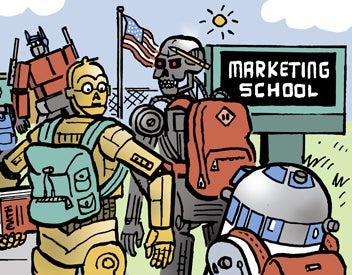
It’s time to step on the gas. Mobile marketing may be expensive, but there’s never been a better time to hit the road.
That’s because, for the first time in about 10 years, road travel is expected to be way down, 30% or more, and that is translating into big bargains.

Lower rates or added value can be had for vehicles, display assets and space at fairs, festivals, NASCAR events, malls, home and garden events and other venues as mobile marketing companies work to secure the business.
“There’s a general softness in display space marketing. Agencies and brands need to take advantage of that and negotiate hard for the space,” says Brad Harris, vice president of strategy for Next Marketing.
For example, the typical 53-foot display space at NASCAR that cost $40,000 last year can be had this year for $25,000 to $35,000, he says.
That’s big savings. But there’s more. Here are 11 other ways for marketers and agencies to chip away at the costs of vehicle marketing:
- Downsize
Tractor trailers can be a huge expense. Try parking that big-rig and leasing one or more street-legal-size cars or trucks. Because the vehicles fit in any metered parking spot, they don’t require multiple parking spaces or special permits like the big trucks do.
“A handful of quarters gets you a great parking space versus spending tens of thousands of dollars for a tractor-trailer spot,” says Sean Conciatore, vice president and creative director for Stage Active Brand Marketing.
- Do the unexpected
It’s not the size of the vehicle, it’s what you do with it that matters. A small vehicle can be tricked out to make a big impact. Remember the Smart Cars that Lindt converted to look like Easter bunnies and that used to buzz around cities sampling Lindt Gold Bunny chocolate candies around Easter time?
- Try spot graphics
Instead of developing a full-vehicle wrap, use spot graphics on each side of the vehicle, the back and the doors. This can save big on the production, installation and removal of the wrap. The average wrap for a big-rig can cost $15,000 to $20,000, compared to $3,000 to $4,000 for spot graphics.
“If you’re wrapping a vehicle, 80% is not your logo anyway, it’s color or design,” says Matthew Glass, CEO, Grand Central Marketing. “If the important thing is to put on some words or logos, you can do that without having the whole background designed with colors and graphics. Anyone can put the smaller decals on.”
- Make sure there is a lift gate
This may seem like a no-brainer, but it will help cut down the load-in and load-out time. A lift gate eliminates the need to rent a forklift or ramp, or to hire additional staff to handle heavy equipment.
- Maximize your space
For a small investment you can outfit the interior of the vehicle to best utilize the height and depth of the truck when packing. In some cases, careful packing can mean that you’ll need just one vehicle instead of two. Or it can allow you to save on shipping display materials.
“There’s an art to packing your truck,” Glass says.
- Don’t zigzag
This might seem like Mobile Marketing 101, but brand marketers still tend to want to go where they want, when they want — even if doesn’t make economical sense. Routing needs to be carefully thought out to maximize the dollars spent and days on the road. Some agencies are partnering with retailers to make stops in between event sites to reduce site fees and make better use of the time on the road, says Lori Schweiger, vice president of business development at GMR Marketing.
- Settle for No. 2
Don’t get stuck on one particular event. There are any number of events that can deliver the same audience, and some alternatives might make more sense from a logistical standpoint. Cutting back on time on the road saves on payroll, hotel bills, fuel, insurance and rental costs.
“If you get emotionally invested in one event or series of events, you’re going to be doing a lot of driving that isn’t necessary,” Next Marketing’s Harris says. “And if you’re driving, you’re not exhibiting.”
- Go second hand and save
Significant cost savings can be had by repurposing existing or used display assets such as demonstration units. Brands often have properties in-house that can be reworked for mobile tours.
One bonus? These assets have already shown that they transport easily, and can mean as much as a $50,000 to $60,000 savings over using new items — even for a moderate footprint event. And with the maturation of the mobile market, there is plenty of used equipment to be found. For example, a used double-expanded trailer can be had for about $200,000, or 50% of its original $400,000 cost.
“Check the closets,” Harris says.
- Consider ready-made
utside designers assume everything is going to be custom manufactured. Encourage them to look at ready-made display properties that might serve the same purpose. These can be copied and may cost less than half of a custom-made piece.
- Swing your partner Partner
with complementary brands to split the cost of a road trip. An increasing number of multiple brands under the same corporate umbrella, or non-competitive brands, are receptive to mounting a group tour to spread out the expenses. Most issues can be ironed out between the partners, and the tours can offer a more compelling experience for the consumer, Harris says.
- Leverage internal resources
Brand companies have armies of internal employees ready, willing and able to staff local events, reducing that line item. After the costs of the vehicles and display assets, staffing is the largest expense of a road show. McDonald’s ran an employee contest to staff its pavilion at this past summer’s Olympics. Beneficial Finance Group did the same to staff booths at a NASCAR event.
“The internal people are the best ones to talk about the brand and the products,” Harris says. “The brand is better represented by using the people who live it and breathe it every day.”
For more articles on experiential marketing, go to http://promomagazine.com/eventmarketing/

 Network
Network

